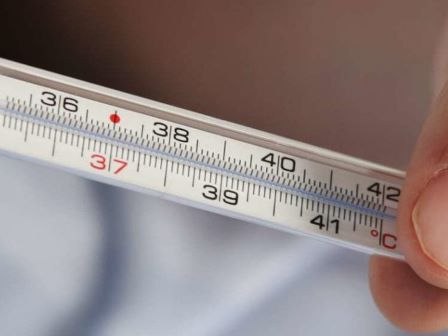Normal body temperature in a healthy person is a range that fluctuates throughout the day. Body temperature can vary as much as 1.0° to 2.0°F (0.5°C to 1.0°C) and is lowest in the morning (2-4 AM) while resting and is warmest in the afternoon (4-6 PM) while active.
Up to 5% of the population has a body temperature that falls outside of the normal range. Body temperature variation is the result of an individual’s metabolic rate.
Slower equals cooler and faster means higher normal body temperature. Metabolic rate is determined by factors such as genetic makeup, lifestyle, age, and environment.
Body temperature is regulated by the hypothalamus that continuously adjusts the temperature to stay within a set range of normal in the absence of illness.
When there is an infectious process, routine monitoring of body temperature can aid early detection, which is an effective measure to prevent the spread of infectious diseases.

What temperature is considered a fever?
Fever is defined as a temperature above an individual’s normal range.
Fever occurs from an infection or inflammation or can also be caused by noninfectious illnesses such as stroke, blood clots, or gout attacks.
- Different sites equal different temperatures:
- Rectal temperature is typically higher than Core
- Core is typically higher than Oral
- Oral is typically higher than Axillary
Should I add/subtract a degree?
This question can only be answered based on the individual situation. A thermometer will do this accurately, to measure the temperature of the place where the thermometer is placed.
No internal offsets are used to adjust the temperature to an oral equivalent. Many facilities simply report a temperature along with the site used.
Normal body temperature ranges
Normal body temperature is a range. This table shows that normal temperatures vary by site. Therefore, readings from different sites, even if taken at the same time, should not be directly compared.
| Fahrenheit | 0 – 2 years | 3 – 10 years | 11 – 65 years | > 65 years |
| Oral | – | 95.9 to 99.5 | 97.6 to 99.6 | 96.4 to 98.5 |
| Rectal | 97.9 to 100.4 | 97.9 to 100.4 | 98.6 to 100.6 | 97.1 to 99.2 |
| Axillary | 94.5 to 99.1 | 96.6 to 98.0 | 95.3 to 98.4 | 96.0 to 97.4 |
| Ear | 97.5 to 100.4 | 97.0 to 100.0 | 96.6 to 99.7 | 96.4 to 99.5 |
| Core | 97.5 to 100.0 | 97.5 to 100.0 | 98.2 to 100.2 | 96.6 to 98.8 |
Body temperature chart for adults
The average body temperature is 98.6 F (37 C) for adults
| Celsius | Fahrenheit | ||
| Low body temperature | < 35.0° | < 95.0° | Hypothermia |
| Normal body temperature | 36.5° – 37.5° | 97.7° – 99.5° | Normal |
| High body temperature | 38.0° | 100.4° | Hyperthermia |
| high fever | 39.4° | 103° | Hyperpyrexia |
Low body temperature
Hypothermia occurs when your body temperature drops below 95 F (35 C).
Hypothermia is a medical emergency that occurs when your body loses heat faster than it can produce heat, resulting in a dangerously low body temperature. Normal body temperature is around 98.6 F (37 C).
Normal body temperature
Las temperaturas pueden variar a lo largo del día, subiendo hasta 1 grado por la mañana y alcanzando un máximo al final de la tarde. Los aumentos leves pueden deberse al ejercicio, demasiada ropa o ropa de cama, tomar un baño caliente o estar al aire libre en un clima caluroso.
High body temperature
Adults usually have a fever if their body temperature rises to 100.4 ° F (38 ° C). This is called a low fever. High fever occurs when your body temperature is 103 ° F (39.4 ° C) or higher.

Celsius to Fahrenheit Fever
Human body temperature information and conversion tables include normal, high and low readings and fever readings from Celsius to Fahrenheit.

Infrared Thermometer for Humans
Infrared thermometers for humans allow users to measure body temperature quickly and non-invasively.

Human Body Temperature
Normal human body temperature varies by person, age, activity, and time of day.
